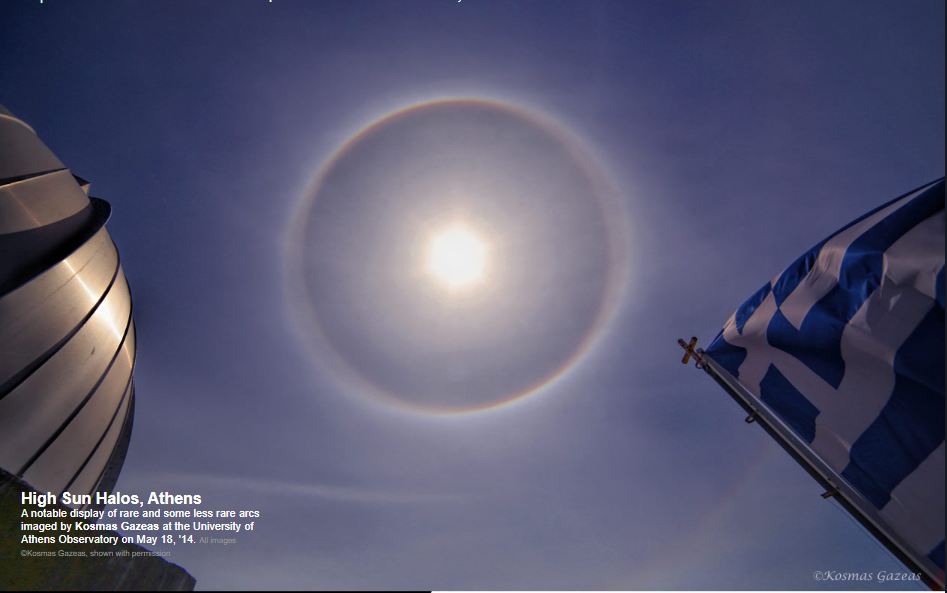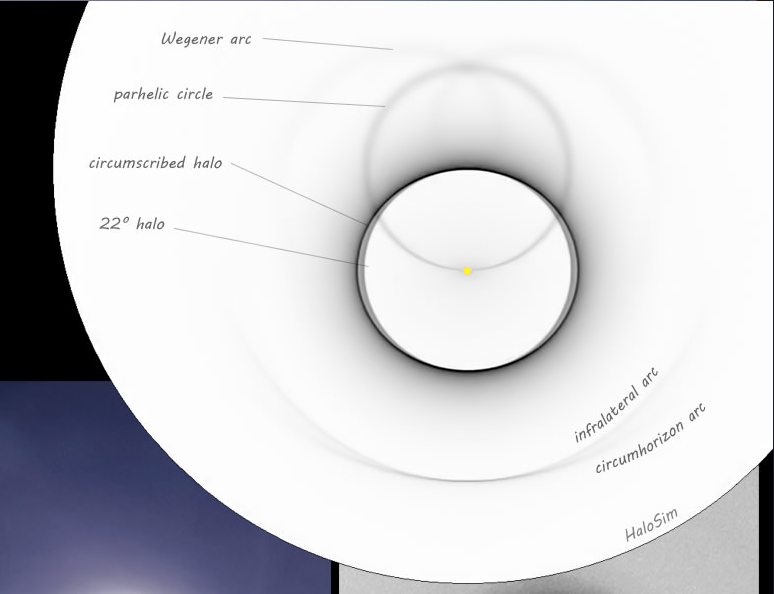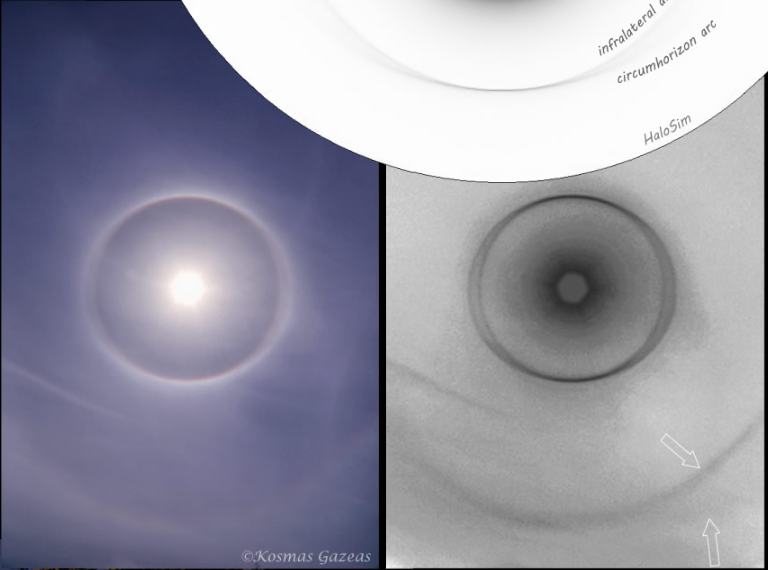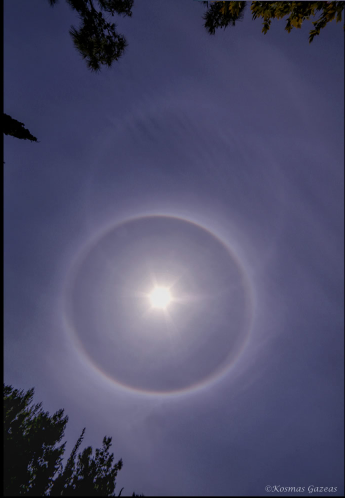Athens High Sun Halos - OPOD
Athens High Sun Halos: A Rare and Beautiful Atmospheric Phenomenon
Athens, the capital city of Greece, is known for its rich history, ancient architecture, and vibrant culture. However, it is also home to a mesmerizing atmospheric phenomenon known as "High Sun Halos." These rare optical displays occur when sunlight interacts with ice crystals in the atmosphere, creating stunning arcs and circles around the sun. On May 18, '14, Kosmas Gazeas, an astronomer at the University of Athens Observatory, captured a remarkable series of images showcasing these captivating halos.
The Composition of High Sun Halos
The High Sun Halos observed in Athens were composed of a mixture of hexagonal ice columns and randomly oriented columns. These ice crystals, drifting with their long axes nearly horizontal, played a crucial role in the formation of the halos. Additionally, some hexagonal plates were also present, adding further complexity to the display.
The 22° Halo and the Circumscribed Halo
Nearest to the sun, we can observe the common 22° halo, which is formed by randomly oriented ice crystals. This halo appears as a circular ring around the sun. However, at the sun's high altitude of 68 degrees, this halo loses its usual "droopy" shape and transforms into a tight oval.
Touching the 22° halo above and below the sun is the circumscribed halo, which is formed by the horizontal ice columns. This halo is visible due to the rays passing between the side and end faces of these columns. Its appearance becomes more distinct as it extends further from the sun.
Additional Halos: 46° Halo and Circumhorizon Arc
Twice as far from the sun, two more halos become visible. One of them is a strong, almost circular arc, while the other is a weaker arc extending further from the sun. The stronger arc could be interpreted as a 46° halo, but it lacks any sign above the sun. On the other hand, the 22° halo formed from the same ice crystals is comparatively weak. A more plausible explanation for this phenomenon is the presence of an infralateral arc, which fits the images and naturally appears in HaloSim ray tracing simulations.
The weaker arc touching the infralateral arc is the circumhorizon arc, which is typically formed by horizontal plates. This arc, although less frequent, is still a fascinating addition to the High Sun Halos display.
The Absence of Sundogs
Plate crystals, which usually give rise to sundogs or 22° parhelia, did not appear over Athens during this particular event. The sun's high position in the sky prevented the formation of these colorful phenomena.
The Enigmatic Parhelic Circle
One of the highlights of the High Sun Halos display captured in Athens is the small parhelic circle. This circle is formed by reflections from the end faces of the numerous horizontal ice columns present in the atmosphere. The weakness of the circumscribed halo suggests a scarcity of plates, which are typically the primary source of the parhelic circle.
Unanswered Questions and Imperfections
Despite our best efforts to understand and explain every aspect of these atmospheric optics phenomena, some mysteries remain. For example, HaloSim simulations suggest the presence of a weak Wegener arc. However, careful enhancement of the images fails to reliably capture this arc. Possible explanations include imperfections on the column end faces or bubble inclusions within the ice crystals. Unfortunately, we may never fully unravel these enigmas.
Appreciating the Circumscribed Halo
Often mistaken for a 22° halo, the circumscribed halo deserves better recognition. It displays more saturated colors and sharper edges compared to its more common counterpart. By distinguishing and appreciating the unique characteristics of the circumscribed halo, we can gain a deeper understanding of the intricate beauty of atmospheric optics.
In conclusion, the High Sun Halos observed in Athens on May 18, '14, presented a remarkable display of rare and less common arcs. Through the interaction of sunlight with various ice crystal formations, these halos formed intricate patterns around the sun. The images captured by Kosmas Gazeas offer a glimpse into the awe-inspiring beauty of atmospheric optics and remind us of the fascinating phenomena that occur above us in the sky.

High Sun Halos, Athens
A notable display of rare and some less rare arcs imaged by Kosmas Gazeas at the University of Athens Observatory on May 18, '14. All images ©Kosmas Gazeas, shown with permission

A mix of (1) hexagonal ice columns drifting with their long axes nearly horizontal, (2) randomly oriented columns of some kind and (3) a few hexagonal plates formed this display.
Nearest the sun is the common 22� halo from the randomly oriented crystals. Touching it above and below the sun is the circumscribed halo from the horizontal columns. At the sun�s high altitude of 68 degrees this halo has lost its low sun �droopy� shape and is instead a tight oval.
Twice as far from the sun there are two more halos. One is just visible next to the Greek flag in the top image. They can be better seen in the two images at lower right one of which is enhanced by colour subtraction. There is a section of a strong almost circular arc and tangent to it a much weaker arc extending further from the sun. The stronger arc might be interpreted as a 46 degree halo. However, there is no sign of it above the sun and the 22 degree halo formed from the same crystals is comparatively weak. An infralateral arc formed by rays passing between the side and end faces of horizontal columns fits the images. It also appears naturally in the HaloSim ray tracing at right using just enough horizontal columns of medium length to make the circumscribed halo and parhelic circle. The weaker arc touching the infralateral (it appears on two images but we cannot be wholly certain of its existence) is the usually more frequent circumhorizon arc made by horizontal plates.
Plate crystals of course give sundogs or 22� parhelia but they did not appear over Athens because the sun was too high to allow them to form.
A star of the show is the small parhelic circle seen best in the image below. It was mostly formed by reflections from the end faces of the plentiful horizontal columns. The weakness of the circumscribed halo suggests a scarcity of plates, the more usual major source of the parhelic circle.
HaloSim shows a weak Wegener arc. Careful enhancement fails to show it reliably in the images. We could invoke imperfections on the Athenian column end faces (but we see an infralateral arc!) or bubble inclusions. We shall never know.


Above the sun and the inner 22 degree and circumscribed halos is a ghostly and small parhelic circle.
The sun was 68° high making the circle just 22° radius - coincidentally the same as the 22° halo.
The width of the parhelic circle suggests that the column crystals forming it had wobbles of 1° or so about their horizontal axes.
Note the almost circular circumscribed halo. A great many of them are mistaken for a 22° halo.
They deserve better recognition. They have more saturated colours and are sharper.
Note: this article has been automatically converted from the old site and may not appear as intended. You can find the original article here.
Reference Atmospheric Optics
If you use any of the definitions, information, or data presented on Atmospheric Optics, please copy the link or reference below to properly credit us as the reference source. Thank you!
-
<a href="https://atoptics.co.uk/blog/athens-high-sun-halos-opod/">Athens High Sun Halos - OPOD</a>
-
"Athens High Sun Halos - OPOD". Atmospheric Optics. Accessed on April 19, 2024. https://atoptics.co.uk/blog/athens-high-sun-halos-opod/.
-
"Athens High Sun Halos - OPOD". Atmospheric Optics, https://atoptics.co.uk/blog/athens-high-sun-halos-opod/. Accessed 19 April, 2024
-
Athens High Sun Halos - OPOD. Atmospheric Optics. Retrieved from https://atoptics.co.uk/blog/athens-high-sun-halos-opod/.